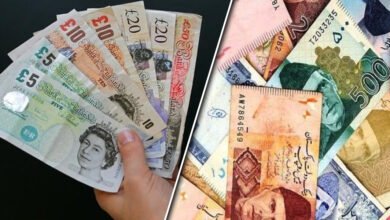Dollar Rallies and Gold Sinks as Fed Rate Cut Hopes Recede
The dollar index (DXY00) Friday rose by +0.75% and posted a 1-week high. The dollar jumped Friday on the stronger-than-expected US May payroll report, which reduced expectations for Fed rate cuts. May nonfarm payrolls rose more than expected and May average hourly earnings unexpectedly accelerated, hawkish factors for Fed policy. Weakness in the euro also boosted the dollar after the Bundesbank cut its German 2024 GDP forecast today.
US May nonfarm payrolls rose +272,000, stronger than expectations of +180,000. The May unemployment rate unexpectedly rose +0.1 to 4.0% versus expectations of no change at 3.9%.
US May average hourly earnings rose +0.4% m/m and +4.1% y/y, stronger than expectations of +0.3% m/m and +3.9% y/y.
US consumer credit news was weaker than expected and bearish for the dollar. Apr consumer credit rose +$6.053 billion, weaker than expectations of +$10.000 billion. Also, Mar consumer credit was revised downward to a contraction of -$1.099 billion from the previously reported increase of +$6.274 billion.
The markets are discounting the chances for a -25 bp rate cut at 1% for the June 11-12 FOMC meeting, 8% for the following meeting on July 30-31, and 50% for the meeting after that on Sep 17-18.
EUR/USD (^EURUSD) on Friday fell by -0.080% and posted a 1-week low. The euro tumbled Friday after the dollar rallied on the stronger-than-expected US May nonfarm payroll report. The euro was also under pressure after German Apr industrial production unexpectedly declined and after the Bundesbank cut its German 2024 GDP forecast.
The euro was supported Friday on stronger-than-expected German trade news for April. Also, the Eurozone Q1 compensation per employee, the ECB’s preferred measure of wages, unexpectedly accelerated, a hawkish factor for ECB policy.
The Eurozone Q1 compensation per employee, the ECB’s preferred measure of wages, rose +5.1% y/y, stronger than expectations of an easing to +4.6% y/y and an acceleration from +4.9% y/y in Q4.
ECB Executive Board member Schnabel said, “As the future inflation outlook remains uncertain, the ECB cannot pre-commit to a particular interest rate path.”
German Apr industrial production unexpectedly fell -0.1% m/m, weaker than expectations of +0.2% m/m.
German trade news was better than expected after Apr exports rose +1.6% m/m, stronger than expectations of f+1.1% m/m. Also, Apr imports rose +2.0% m/m, stronger than expectations of +0.5% m/m.
The Bundesbank cut its German 2024 GDP forecast to +0.3% from a previous forecast of +0.4% and raised its German 2024 inflation forecast to +2.8% from a prior estimate of +2.7%.
Swaps are discounting the chances of a -25 bp rate cut by the ECB at 20% for the July 18 meeting and 53% for the September 12 meeting.
USD/JPY (^USDJPY) Friday rose by +0.66%. The yen was under pressure Friday based on comments from Japanese Minister of Finance Suzuki, who said authorities should resort to currency intervention only on a limited basis, which curbed speculation that Japan will intervene in the forex market again to support the yen. Losses in the yen accelerated Friday after T-note yields jumped on the stronger-than-expected US May nonfarm payroll report.
The Japan Apr leading index CI fell -0.1 to 111.6, right on expectations.
Japan’s April household spending rose +0.5% y/y, the fastest pace of increase in 14 months.
Swaps are pricing in the chances for a +10 bp rate increase by the BOJ at 12% for the June 14 meeting and at 63% for the July 31 meeting.
August gold (GCQ4) Friday closed down -65.90 (-2.76%), and July silver (SIN24) closed down -1.927 (-6.14%). Precious metals on Friday sold off sharply, with gold tumbling to a 1-month low and silver falling to a 3-week low. Precious metals retreated Friday after the dollar jumped to a 1-week high on the stronger-than-expected US May nonfarm payroll report, which curbs the chances that the Fed will cut interest rates anytime soon. Also, higher global bond yields on Friday were negative for precious metals. Reduced gold buying by China’s central bank also weighed on gold prices as the PBOC in May did not purchase gold for its reserves for the first time in 18 months. Silver prices were also weighed down after German Apr industrial production unexpectedly declined and the Bundesbank cut its German 2024 GDP forecast, bearish factors for industrial metals demand.
A supportive factor for gold is sticky global wage pressures that boost demand for gold as an inflation hedge after US May average hourly earnings rose more than expected and the Eurozone Q1 compensation per employee unexpectedly accelerated.
More Forex News from Barchart
On the date of publication, Rich Asplund did not have (either directly or indirectly) positions in any of the securities mentioned in this article. All information and data in this article is solely for informational purposes. For more information please view the Barchart Disclosure Policy here.
The views and opinions expressed herein are the views and opinions of the author and do not necessarily reflect those of Nasdaq, Inc.
Source link





